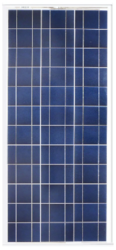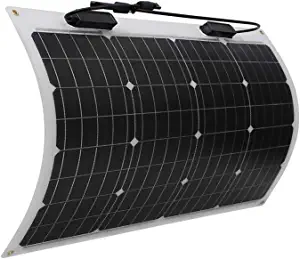
When it comes to making sure your boats batteries are charged while on the water or on a mooring, solar charging systems have become by far the best option.
Since solar panels are available as both hard and flexible panels, there are many mounting options available when it comes to designing a system that meet your power requirements, while maintaining the look and aesthetics of your boat.
With anything related to boats, there are always compromises and tradeoffs that come into play, especially when it comes to solar charging systems. This article is hopes to address and answer some of the questions to help you determine which system and installation method might be right for you and your boat.
Solar Panel Options
Hard Panels
Hard solar panels have been around since the beginning of solar panel construction.

When considering Dollar/Watt, they are by far the most affordable, and additionally have the longest usable life when compared to flexible solar panels - roughly 20 years. Additionally, hard panels lend themselves to mounting methods not available to many flexible solar panels such as mounting on davits, solar arches, and lifeline rails.
The downside to hard solar panels is they are heavy, the glass top cover is susceptible to damage from sea gulls dropping crabs and other prey, and they cannot be walked on or stepped on.
Flexible Panels
Flexible solar panels are relatively new to the solar world, but many options are now available in a variety of different price ranges. Flexible solar panels lend themselves well to being easily integrated into most boats in very unobtrusive way. They can be mounted on Canvas such as a dodger and bimini, or they can hard mounted on a

deck with no risk of damage if walked or stepped on. When it comes to getting mounted on a deck, panels can be selected that have the diode boxes on the underside removing any potential tripping hazards.
Are flexible panels too good to be true? Of course. The main downside to flexible solar panels is their life span. Most flexible solar panels are only warrantied to 5 years and have a maximum lifespan of 10 years.
When it comes to maximizing the life span of a flexible solar panels, there are several key elements that will shorten the life of the panel.
Bending: The biggest area of wear and tear introduced to a flexible solar panel is through excessive bending. Most of panels have a maximum flex of 20 degrees, and by bending the panels further introduces the risk of cracking and damaging the silicone solar cells. Additionally, the more these panels flex and bend the higher the risk of these cells becoming damaged over time. Flexible solar panels are most susceptible to damage when they are bent inward as it puts directly on the silicon solar cells.
Delamination: Delamination is one of the leading causes to flexible solar panels failing. Delamination can be caused by excessive bending, or water intrusion through sewed on velcro or zipper canvas attachment method (which is why we now use 3M 5200 to attach our velcro for canvas installations.
ETFE vs. PET
Flexible solar panels on the market today come in two variations. ETFE (ethylene tetrafluoroethylene) and PET (Polyethylene terephthalate). ETFE is a newer technology and far better than PET in just about every way, with the exception of cost.

Performance of ETFE vs PET
Material | ETFE | PET |
Combination | Ultra lightweight and durable. The combination between ETFE and back sheet is much stronger than PET. | Combination of PET and back sheet cracks easily, is not durable, and also not waterproof. |
Thickness | Includes a 0.025mm thin, UV resistant, layer of protection. Total thickness less than 0.1mm. | 0.15mm thick. Solar cells break easily due to low hardness. |
Light Transmission | 95% transparency offers excellent efficiency in terms of light to electricity conversion. | 90% to 93% transparent results in lower efficiency in terms of light to electricity conversion. |
Surface Adhesion | ETFE has non-adhesive surface properties. Highly stain-resistant and easily gets cleaned by the rain. | Adhesive surface often gets covered with dust or other debris, significantly affecting the output of solar panel. |
Lifetime | Lifetime of 10 years. Resists aging, deteriorates slowly. | Lifetime of at most 5 years. Easily forms air pockets and peels off. |
Corrodibility | Highly resistant to seawater corrosion. | Not acid and alkali resistant, making it totally unsuitable for use in marine environment. |
Flammability | Highly flame retardant. Suitable for use in temperatures ranging from -65°C to +150°C. Can be installed safely in hot climates. | Not suitable for use in high temperature regions due to short-term heat resistance. |
Light Reflection | Absorbs sunlight. Does not reflect it. | Reflects a large amount of sunlight, producing glare and creating traffic risks to cars and airplanes. |
Charge Controllers
Charge controllers are an essential piece to any solar installation. The purpose of a charge controller is to reduce the voltage of the solar panel to the charge profile of the battery bank.
There are two types of charge controllers available, being MPPT and PWM.
MPPT (Maximum Power Point Tracking)
MPPT charge controllers are by far the best type of solar controller, and honestly the only controller you should be using for your solar charging system. The reason for this being efficiency. An MPPT controller works by stepping down the voltage of the solar panels and boosting the output amperage. These controllers efficiency is generally

between 94%-97% efficient in converting the energy produced by your solar panels into your batteries.
The only downside to these chargers is that they are more expensive, but when considering the limited restate available on most boats, maximizing the efficiency of a solar system is usually the only way to meet the power requirements you need. Additionally, with this higher price point, many additional features are often included with these controllers such as Bluetooth connectivity allowing you to see your solar output in real time. Our MPPT controllers of choice are made by Victron.
PWM (Pulse Width Modulation)
PWM controllers have been around for a very long time, they are cheap, and often included in most solar starter packs. PWM controllers work by lowering the voltage to a

usable amount to charge a battery bank. With this type of technology, the efficiency of the controller could be as low as 50% of the solar array output, which is a big reason why we do not advise using this on marine installations.
As a cheaper product, quality control is not always a top priority for these manufacturers, and we have seen them overcharge a battery causing it to explode.
Monocrystalline/Polycrystalline
While new solar cell technologies are development, solar panel cells come in two varieties: Monocrystalline and Polycrystalline. But to completely transparent, when designing a solar system for a boat we always choose monocrystalline panels due to the advantages below.
Monocrystalline: These solar cells are made of solid silicon crystal. Since the cells are made of a solid crystal, they allow better electron flow resulting in a higher efficiency and smaller panel. These panels do cost more than polycrystalline, but with increased world-wide panel production, the prices have dropped significantly making them the go to option when designing a solar system on a boat.
Polycrystalline: These cells are made from multiple fragments of silicon which are then melted together. The construction of polycrystalline cells does tend to be more environmentally friendly as most of the silicon is used in the manufacture process, which equates to less waste. Unfortunately, these panels are less efficient and have a lower heat tolerance than monocrystalline due to the lower silicon purity used, and as such have lower efficiency at high temperatures (very common during the summer boating season).
How many watts do I need?
The first question we get asked when starting any solar design/installation job is "How many solar panels do I need?" If you are only looking to run refrigeration, the lowest we recommend is a combined array of 300 watts.
There is much more to consider with regards to house bank capacity, ice box insulation efficiency, required recharge time and how what other equipment you may be using, but we generally try to design each solar system with incorporating as much wattage as possible with the available real estate.
Whether the array is on canvas, the deck, or davits, the most expensive part of any installation is running the wires and having to do this once is always the most cost efficient.
Mounting Options
When it comes to deciding on a location and mounting solar panels, there are many options available. On many solar system installations, we will incorporate both flexible and hard panels to meet the wattage requirements.
Our goal is to meet the wattage requirements while keeping your boat beautiful, so if you are considering solar and not sure where to start, give us a call!
